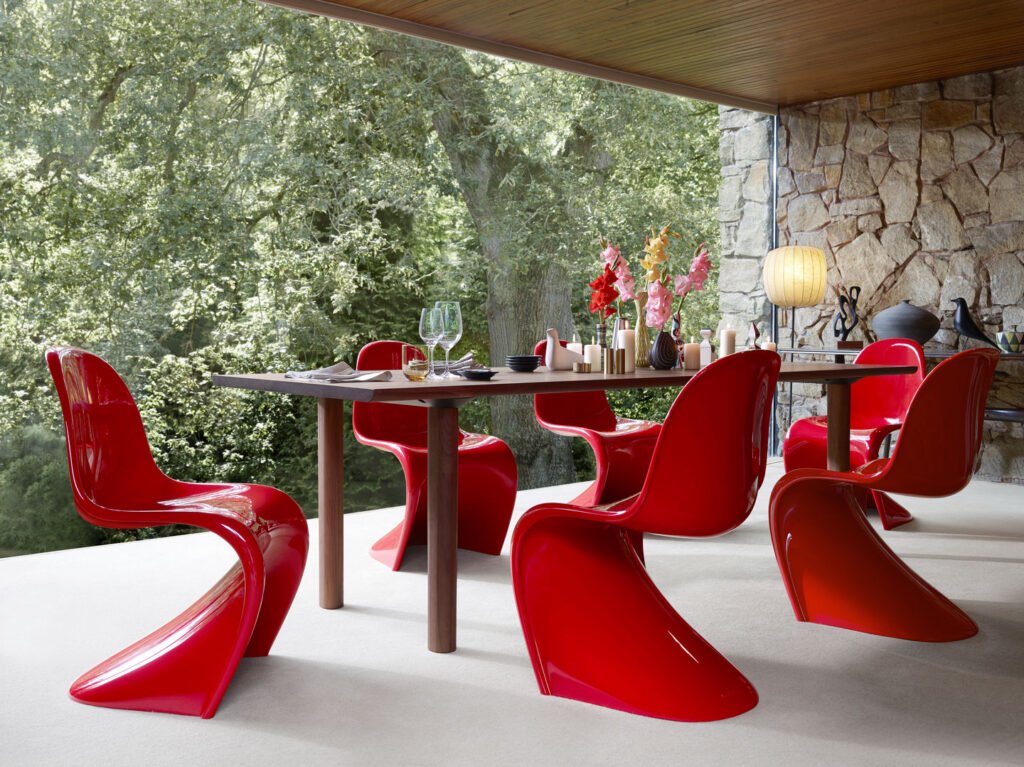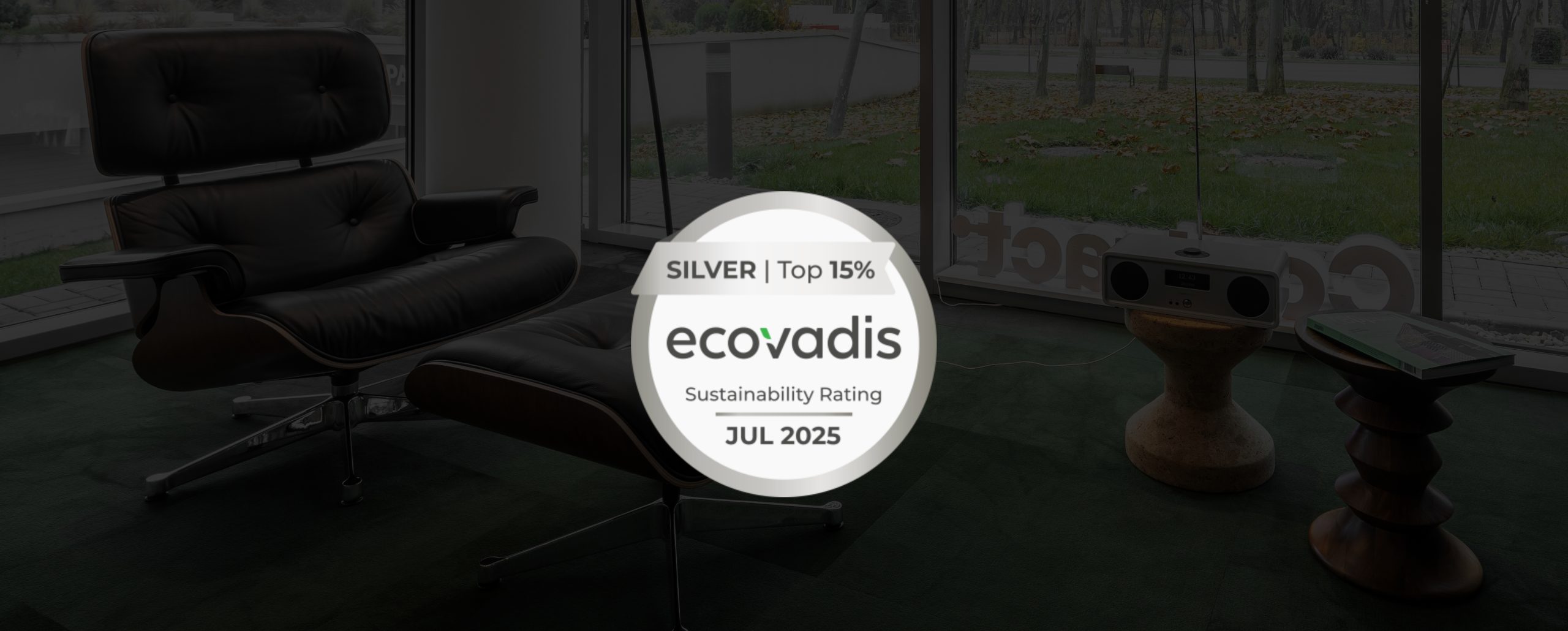
News and views

The Panton Chair’s curves have become an iconic sight, even though when Verner Panton first proposed the chair to manufacturers in the 1950s, they all considered it a daring concept and even an impossibility. All but Vitra, who embraced the innovative design and, together with Panton, took up the challenge of bringing it to market. It didn’t take long until this revolutionary chair achieved the status of a classic in the history of furniture design.
Did you know that the Panton Chair was the first product developed for serial production by Vitra in collaboration with a designer? In fact, the history of the Panton Chair begins in the latter half of the 1950s, when Danish designer Verner Panton explored the idea of a cantilever chair made entirely of plastic. Shortly after, he began looking for a manufacturer to produce this masterpiece, but most of them did not want to persue this concept.
“Rolf [Fehlbaum, son of the Vitra founding family] came to visit us one day and spotted a prototype of the Panton chair. It wasn‘t stable enough to sit on. Rolf asked: ‘Why isn‘t this chair being manufactured?’ I answered, ‘Fifteen to twenty manufacturers have tried it but have all rejected the project for different reasons.’ A well-known American designer – not Eames – even declared that something like that shouldn‘t be called a ‘chair’– claiming it was not suitable to sit on. Rolf was immediately on the phone to a Vitra technician, Manfred Diebold. […] Without Rolf there would have been no Panton Chair.” – Verner Panton
So, the year 1963 marked the start of his collaboration with Vitra, and the Panton Chair was launched on the market in 1967. It turned out to be a nearly impossible challenge, as the bold contours imagined by the designer had to be reconciled with the physical limits of plastics technology and manufacturing requirements. It involved several years of research, testing, discarded designs and continuous prototype development. The final shape of the chair was the result of ten prototypes made of manually laminated, glass-fibre reinforced polyester. Verner Panton and Vitra developers worked persistently and steadfastly on the project, sacrificing their evenings and weekends.

Since its introduction to the market, it has advanced through several production phases. In 1967, a small pilot series of just 150 pieces was manufactured, using cold-pressed, glass-fibre reinforced polyester. It was the first all-plastic chair to be made in one single piece, with a cantilever design.
Technological advancements in plastics technology enabled Vitra and Verner Panton to develop a version of the Panton Chair in polypropylene at the end of the 1990s. Available since 1999, this version of the chair matches Panton’s original concept: it is produced from durable, dyed-through plastic with a lustrous matt finish. In fact, from its initial design to the latest iterations, the Panton Chair was a work in progress for more than 40 years.
The Panton Chair has received numerous international design awards and is represented in the collections of many prestigious museums all around the world, including Museum of Modern Art in New York. Due to its expressive form, it has become an icon of the 20th century. Its extraordinary comfort results from the combination of a cantilever structure with an anthropomorphic shape and a slightly flexible material. It can be used individually or in groups and is suited for both indoor and outdoor environments.

Verner Panton was one of the most influential figures in the development of design during the 1960s and ’70s. The Danish designer became known for his inventive, novel ideas for furnishings, lighting and textiles. The masterful use of colour was a hallmark of his work. Along with his experimental approach to forms and colours, he was captivated by the potential of plastic, a novel material at the time.
Furthermore, Verner Panton’s passion for bright colours and geometric patterns manifested itself in an extensive range of textile designs. By fusing the elements of a room – floor, walls, ceiling, furnishings, lighting, textiles and wall panels made of enamel or plastic – into a unified gesamtkunstwerk, Panton’s interior installations have attained legendary status. The most famous examples are the ‘Visiona’ ship installations for the Cologne Furniture Fair (1968 and 1970), the Spiegel publishing headquarters in Hamburg (1969) and the Varna restaurant in Aarhus.

Verner Panton created the legendary Fantasy Landscape in 1970 for the ‘Visiona’ installations.

The Spiegel Publishing House in Hamburg is one of Verner Panton’s most famous interior design projects.

The interior of the Varna restaurant in Aarhus (Denmark) was designed by Verner Panton in 1971.
Recommended articles

Project1 Achieves EcoVadis Silver Sustainability Rating
We are proud to share an important milestone in our sustainability journey: Project1 has been awarded the Silver Sustainability Rating by EcoVadis, placing us among the top 15% of companies assessed worldwide. This recognition reflects the work we have done over the past years to integrate sustainability into everything we do – from the way […]

Beyond Furniture: Actiu’s Sustainable Legacy
Actiu, the Spanish benchmark in the design and manufacture of workspace furniture, has long championed sustainability as a fundamental pillar of its operations. With more than 50 years of experience and a presence in more than 90 countries, this family business based in Castalla (Alicante) is an example of how industrial development can coexist in […]
On Instagram
Follow us on Instagram for daily inspiration on amazing spaces and iconic products.

